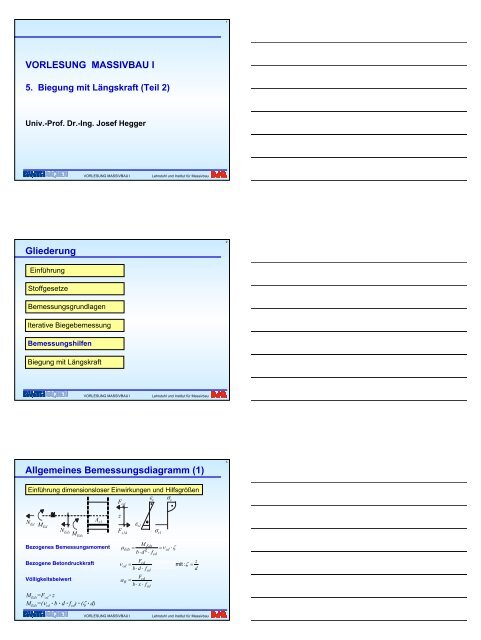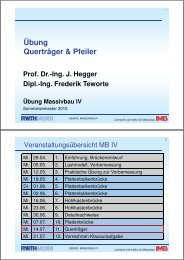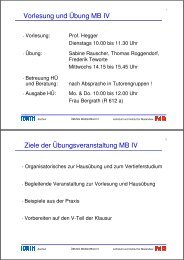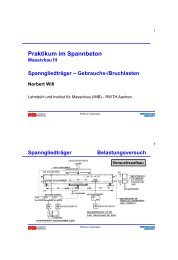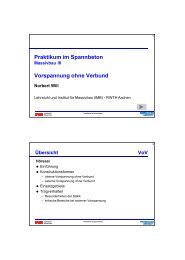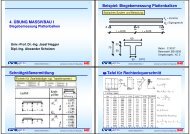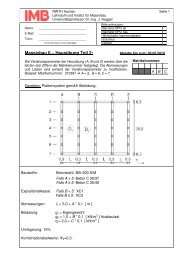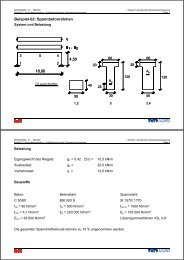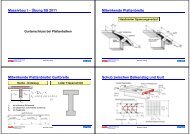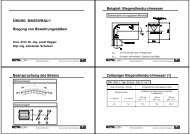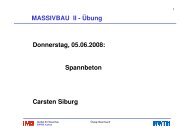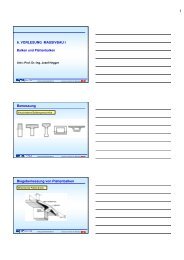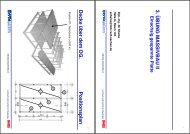VORLESUNG MASSIVBAU I Gliederung Allgemeines ...
VORLESUNG MASSIVBAU I Gliederung Allgemeines ...
VORLESUNG MASSIVBAU I Gliederung Allgemeines ...
Sie wollen auch ein ePaper? Erhöhen Sie die Reichweite Ihrer Titel.
YUMPU macht aus Druck-PDFs automatisch weboptimierte ePaper, die Google liebt.
<strong>Allgemeines</strong> Bemessungsdiagramm (2)4Ablesung in Abhängigkeitvon µ Eds : Dehnungsverteilung(keine Iteration erf.) Hilfsgrößen ξ = x/d;ζ = z/d<strong>VORLESUNG</strong> <strong>MASSIVBAU</strong> ILehrstuhl und Institut für MassivbauDimensionslose Beiwerte (1)5Eingangswert:MEdsµ Eds = = νcd⋅ζ2b⋅d⋅ fcd1 ⎛ M Eds ⎞erf As1= ⋅⎜+ NEd⎟σs1⎝ z ⎠1erf As1= ⋅ ( Fcd+ NEd)σs11erf As1= ⋅ ( νcd⋅ b ⋅ d ⋅ fcd+ NEd)σs1mechanischer Bewehrungsgrad :As⋅ σsFsM Edsω = = == νcdb ⋅ d ⋅ fcdb ⋅ d ⋅ fcdb ⋅ d ⋅ z ⋅ fcd1A s1= ⋅ ( ω ⋅b⋅ d ⋅ fcd+ NEd)fyd<strong>VORLESUNG</strong> <strong>MASSIVBAU</strong> ILehrstuhl und Institut für MassivbauDimensionslose Beiwerte (2)6Bemessungstabellen ohne Druckbewehrung<strong>VORLESUNG</strong> <strong>MASSIVBAU</strong> ILehrstuhl und Institut für Massivbau
1. Berechnungsbeispiel - Teil 27Ergebnis der iterativen Bemessungh =50d =45A s1 z s1= 20Beton: C 20/25Betonstahl: BSt 5005b=30erf A s1 = 8,32 cm²Gewählt: 5 ∅ 16 ⇒ vorh A s1 = 10,1 cm²<strong>VORLESUNG</strong> <strong>MASSIVBAU</strong> ILehrstuhl und Institut für Massivbau1. Berechnungsbeispiel - Teil 28Benutzung von BemessungshilfenEinwirkende Schnittgrößen bezogen auf die Bewehrungslage:M EdsN Eds= 155,4 kNm= -42 kNEingangswert Bemessungsdiagramm:µ Eds = M Eds / (b ⋅ d 2 ⋅ f cd )= 0,1554 / (0,30 ⋅ 0,45²) ⋅ (0,85 ⋅ 20 /1,5) = 0,226<strong>VORLESUNG</strong> <strong>MASSIVBAU</strong> ILehrstuhl und Institut für Massivbau1. Berechnungsbeispiel - Teil 29z / d = 0,87z / dε= s1 = 7,3 ‰0,87ε s1 = 7,3 ‰µ = 0,226µ = 0,226<strong>VORLESUNG</strong> <strong>MASSIVBAU</strong> ILehrstuhl und Institut für Massivbau
1. Berechnungsbeispiel - Teil 210Ablesung aus dem allgemeinen BemessungsdiagrammAblesung: ε s1 = 7,3 ‰z / d = 0,87 ⇒ z = 0,87 ⋅ 0,45≅ 0,39 m⇒ A s1 = 1/σ s1 ⋅ (M Eds / z + N Eds )= 1 / (500 / 1,15) ⋅ (0,1554 / 0,39 – 0,042) ⋅10 4 = 8,2 cm²Die Ablesung kann auch durch Interpolation aus den ω -Tafeln erfolgen!<strong>VORLESUNG</strong> <strong>MASSIVBAU</strong> ILehrstuhl und Institut für Massivbau1. Berechnungsbeispiel - Teil 211Bemessungsverfahren mit dimensionslosen Beiwerten(ohne Druckbewehrung)ω 1 ≈ 0,262⇒ A s1 = 1/σ sd ⋅ (ω 1 ⋅ b ⋅ d ⋅ f cd + N Eds )= 1 / 440 ⋅ [0,262 ⋅ 0,3 ⋅ 0,45 ⋅ (0,85 ⋅ 20 / 1,5) – 0,042] ⋅10 4 = 8,2 cm²<strong>VORLESUNG</strong> <strong>MASSIVBAU</strong> ILehrstuhl und Institut für Massivbau1. Berechnungsbeispiel - Teil 212Vergleich der BemessungsverfahrenIterative Bemessungerf A s = 8,3 cm²<strong>Allgemeines</strong> Bemessungsdiagrammerf A s = 8,2 cm²Dimensionslose Beiwerteerf A s = 8,2 cm²<strong>VORLESUNG</strong> <strong>MASSIVBAU</strong> ILehrstuhl und Institut für Massivbau
Duktilität13Duktiles Versagen am Beispiel eines BiegeträgersQwQVorankündigung des Versagens Rissbildung zunehmende VerformungSchlagartiges Versagen am Beispiel einer StützeN, MVersagen nicht angekündigt Stabilitätsprobleme unbewehrte Bauteile (Zug / Schub) Druckzonenversagen in Biegeträgern<strong>VORLESUNG</strong> <strong>MASSIVBAU</strong> ILehrstuhl und Institut für MassivbauRotationsfähigkeit ⇔ Druckzonenhöhe x/d14Zugdehnung beider Querschnitte gleich großBalkenC35/45kleine bezogeneDruckzonenhöhegroße bezogeneDruckzonenhöhed(-)xx/d = 0,21(-)xx/d = 0,45(+)(+)! ε c2 = –3,5‰ Rotationsfähigkeit vorhanden Betondruckzone noch nicht vollausgenutzt geringe Rotationsfähigkeit Betondruckzone voll ausgenutzt<strong>VORLESUNG</strong> <strong>MASSIVBAU</strong> ILehrstuhl und Institut für MassivbauVoll ausgenutzte Druckzone15-3,5‰< -3,5‰ε c2uf cd-ε c2σ c < f cd-<strong>VORLESUNG</strong> <strong>MASSIVBAU</strong> ILehrstuhl und Institut für Massivbau
Dimensionslose Beiwerte19ξ = 0,25ξ = 0,35ξ = 0,45ξ = 0,617<strong>VORLESUNG</strong> <strong>MASSIVBAU</strong> ILehrstuhl und Institut für MassivbauDuktilität von Betonstahl20Spannungs-Dehnungs-Linie von kaltverformtem Betonstahlσf tf y0,2 ‰ ε uε uk > |50 ‰ |; (f t / f y ) k > |1,08| hohe Duktilität (Klasse B)ε uk > |25 ‰ |; (f t / f y ) k > |1,05| normale Duktilität (Klasse A)ε<strong>VORLESUNG</strong> <strong>MASSIVBAU</strong> ILehrstuhl und Institut für MassivbauDuktile Bemessung21Gewährleistung eines ausreichenden RotationsvermögensÜberschreitung der bezogenen Druckzonenhöheξ = x/d = 0,45 (Beton bis C 50/60)ξ = x/d = 0,35 (Beton C 55/67 und höhere Festigkeitskl.)⇒Anordnung von Druckbewehrung oderUmschnürung der Druckzone(+)ε sx/d = 0,353,5 ‰(-)xd3,5 ‰(-)(+)ε sx/d = 0,45Ziel: Duktiles Bauteilverhalten<strong>VORLESUNG</strong> <strong>MASSIVBAU</strong> ILehrstuhl und Institut für Massivbau
Bemessung mit Druckbewehrung (1)221.Anteil2. Anteild 2xε c2 =3,5‰ε s2F cdσ s2 =ε s2·E s ≤ f ydF s2dA s2dzd-d 2A s1N EdM Edsε s1 >ε ydσ s1 =f ydF s1dσ s1 =f yd∆F s1dAs1As21 ⎛ M Eds,lim ∆M= ⋅ ⎜ +σ s1⎝ z d − dFs2 ∆MEds= =σ σ ⋅ ( d − d )s2s22Eds ⎞+ Nsd⎟2 ⎠M Eds,lim = F cd · z= F s1d · zDifferenzmoment∆M Eds = ∆ F s1d ·(d-d 2 )= ∆ F s2d ·(d-d 2 )M Eds = M Eds,lim +∆M Eds<strong>VORLESUNG</strong> <strong>MASSIVBAU</strong> ILehrstuhl und Institut für MassivbauBemessung mit Druckbewehrung (2)23Bemessungstabellen mit Druckbewehrung für ξ = 0,45z s2z s1<strong>VORLESUNG</strong> <strong>MASSIVBAU</strong> ILehrstuhl und Institut für Massivbau3. Berechnungsbeispiel24<strong>Allgemeines</strong> Bemessungsdiagramm mit DruckbewehrungGegeben:As2ξ = x/d ≤ 0,455MEdNEdMEdsNEds5As1zs2=35zs1=357580Beton: C 30/37Betonstahl: BSt 500Schnittgrößen:M G = 740 kNmM Q = 200 kNmN G = 115 kNN Q =30kNGesucht:A s1 , A s2<strong>VORLESUNG</strong> <strong>MASSIVBAU</strong> ILehrstuhl und Institut für Massivbau
3. Berechnungsbeispiel25Ermittlung der einwirkenden SchnittgrößenM Ed = γ G ⋅ M G,k + γ Q ⋅ M Q,k =1,35 ⋅ 740 + 1,50 ⋅ 200 = 1299 kNmN Ed = γ G ⋅ N G,k + γ Q ⋅ N Q,k = 1,35 ⋅ 115 + 1,50 ⋅ 30 = 200 kN = N EdsM Eds = M Ed - z s1 ⋅ N Eds = 1229 - 0,35 ⋅ 200 = 1229 kNmµ Eds = Μ Eds / b ⋅ d² ⋅ f cd = 1,229 / [0,40 ⋅ 0,75² ⋅ (30 / 1,5) ⋅ 0.85] = 0,321<strong>VORLESUNG</strong> <strong>MASSIVBAU</strong> ILehrstuhl und Institut für Massivbau3. Berechnungsbeispiel26ξ = 0,500,321<strong>VORLESUNG</strong> <strong>MASSIVBAU</strong> ILehrstuhl und Institut für Massivbau3. Berechnungsbeispiel27Ablesung aus dem allgemeinen BemessungsdiagrammAblesung:ξ = 0,50 > 0,45 (Grenzwert für Rotationsfähigkeit)Gewählte Dehnungsverteilung:ξ= 0,45 ⇒ ε s1 = 4,3 ‰ , ε c2 = -3,5 ‰µ Eds,lim = 0,296 mit ζ = z/d ≅ 0,81M Eds,lim = µ Eds,lim ⋅b ⋅ d 2 ⋅ f cd= 0,296 ⋅ 0,4 ⋅ 0,75² ⋅ 17= 1,132 MNm∆M Eds = 1,229 – 1,132 = 0,097 MNm<strong>VORLESUNG</strong> <strong>MASSIVBAU</strong> ILehrstuhl und Institut für Massivbau
3. Berechnungsbeispiel28Bestimmung erf. A sF cdσ s2 =ε s2·E s ≤ f ydF s2dzd-d 2Zugbewehrung:σ s1 =f ydF s1dσ s1 =f yd∆F s1d⇒ erf. A s1 = 1/σ s1 ⋅ (M Eds,Lim / z + ∆M Eds / (d - d 2 )+ N Eds )= 1 / (435) ⋅ [1,132 / 0,81 ⋅ 0,75 + 0,097 / (0,75-0,05) + 0,200] ⋅ 10 4Druckbewehrung:= 50,62 cm²⇒ erf. A s2 = 1/σ s2 ⋅ ∆M Eds / (d - d 2 )= 1 / (435) ⋅ [0,097 / (0,75-0,05)] ⋅ 10 4= 3,2 cm²<strong>VORLESUNG</strong> <strong>MASSIVBAU</strong> ILehrstuhl und Institut für Massivbau3. Berechnungsbeispiel29Alternativ: Bemessungsverfahren mit dimensionslosen Beiwertenohne Druckbewehrung (1)µ Eds = 0,321ω 1 = 0,4038ε s = 3,52 ‰ > 2,17 ‰⇒σ s = f yd = 435 N/mm²<strong>VORLESUNG</strong> <strong>MASSIVBAU</strong> ILehrstuhl und Institut für Massivbau3. Berechnungsbeispiel30Alternativ: Bemessungsverfahren mit dimensionslosen Beiwertenohne Druckbewehrung (2)erf. A s1 = 1 / 435 ⋅ [0,4038 ⋅ 30 ⋅ 0,85 / (1,5 ⋅ 0,4 ⋅ 0,75 ) + 0,2] ⋅ 10 4= 51,9 cm²erf. A s2 = 0x/d = 0,5 > 0,45 ⇒ Umschnürung der Druckzone erforderlichGewählt: Bügel Ø 10/15 cm ** sofern keine andere Umschnürungswirkung vorhanden ist und V Ed ≤ 0,6 V Rd,max<strong>VORLESUNG</strong> <strong>MASSIVBAU</strong> ILehrstuhl und Institut für Massivbau
3. Berechnungsbeispiel31Vergleich der Ergebnisse mit / ohne Druckbewehrungmit Druckbewehrung (x/d = 0,45)a s,B ausQuerkraftbemessungnach DIN 1045-1(z.B. Ø 8/20)ohne Druckbewehrung (x/d = 0,5 > 0,45)Min a s,B Ø10/15erf. A s1 = 50,6 cm²erf. A s2 = 3,2 cm²erf. A s1 = 51,9 cm²erf. A s2 = 0 cm² (konstruktiv)⇒ - ∆A sl = 1,9 cm²- hohe Schubbewehrung zur Umschnürung der Druckzone erforderlich,wenn x/d > 0,45<strong>VORLESUNG</strong> <strong>MASSIVBAU</strong> ILehrstuhl und Institut für MassivbauDimensionsgebundene Beiwerte32k d -Verfahren - Bemessung ohne Druckbewehrungzk =dd[ cm]MEds[ kNm]b[ m]MEds[ kNm]NEd[ kN]As1= ks⋅ +d[ m]43,5<strong>VORLESUNG</strong> <strong>MASSIVBAU</strong> ILehrstuhl und Institut für Massivbau4. Berechnungsbeispiel33Anwendung des k d – Verfahrens nach DIN 1045-1Gegeben:N EdM Edz s1=357580Beton: C 30/37Betonstahl: BSt 500Schnittgrößen:M Ed = 990 kNmN Ed = 142 kNAs1Bemessungsmoment Betonstahllage:M Eds = 940 kNmGesucht:A s1<strong>VORLESUNG</strong> <strong>MASSIVBAU</strong> ILehrstuhl und Institut für Massivbau
Dimensionsgebundene Beiwerte34k d -Verfahren - Bemessung ohne Druckbewehrungzk =dd[ cm]MEds[ kNm]b[ m]MEds[ kNm]NEd[ kN]As1= ks⋅ +d[ m]43,5<strong>VORLESUNG</strong> <strong>MASSIVBAU</strong> ILehrstuhl und Institut für Massivbau4. Berechnungsbeispiel35Anwendung des k d – Verfahrens nach DIN 1045-1Gegeben:N EdM Edz s1=357580Beton: C 30/37Betonstahl: BSt 500Schnittgrößen:M Ed = 990 kNmN Ed = 142 kNAs1Bemessungsmoment Betonstahllage:M Eds = 940 kNmGesucht:A s1<strong>VORLESUNG</strong> <strong>MASSIVBAU</strong> ILehrstuhl und Institut für Massivbau4. Berechnungsbeispiel36Anwendung des k d - Verfahrensd[ cm]75kd== = 1,5511⎛ M Ed [ kNm]⎞2⎛ 940 ⎞2⎜ ⎟ ⎜ ⎟⎝ b[ m]⎠ ⎝ 0,40 ⎠<strong>VORLESUNG</strong> <strong>MASSIVBAU</strong> ILehrstuhl und Institut für Massivbau
4. Berechnungsbeispiel37Auswertung der k d - TafelnAblesung: k s = 2,69ξ = 0,350ζ = 0,854ε c2 / ε s1 = -3,50 / 6,50 ‰⇒ erf. A s1 = k s ⋅ M Eds [kNm] / d [cm] + N Ed [kN] / 43,5= 2,69 ⋅ 940 / 75 + 142 / 43,5= 37 cm²<strong>VORLESUNG</strong> <strong>MASSIVBAU</strong> ILehrstuhl und Institut für Massivbau


